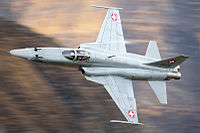
Photo from wikipedia
BACKGROUND: Occupational hazards facing high performance aircraft pilots ("fighter" pilots) can cause injury, time lost from flying, and voluntary or involuntary career termination. The high cost of training and retaining… Click to show full abstract
BACKGROUND: Occupational hazards facing high performance aircraft pilots ("fighter" pilots) can cause injury, time lost from flying, and voluntary or involuntary career termination. The high cost of training and retaining fighter pilots has spurred interest in the cost effectiveness of preventative and rehabilitative health solutions.METHODS: We investigated the potential cost effectiveness of a 5-yr, $24.9M U.S. preventative health program using equivalent annual worth (EAW) analysis. The program benefits were assessed with a combination of actual and estimated medical cost data and projected pilot retention improvement rates. Sensitivity analysis of variables such as discount rate, medical cost avoidance, and pilot retention improvement rate was conducted.RESULTS: Annualized costs of approximately $5M U.S. were used as the basis of comparison for annualized benefits. A medical cost database was searched to find expected annual direct medical (outpatient) costs related to injury of roughly $531K U.S. for the pilots covered by the program. Using Centers for Disease Control recommendations, approximately $4.7M U.S. was estimated to be the annual work loss cost. The program would presumably reduce a significant portion of these annual costs, but not all. Assuming various proportions of reduced costs by the program, the EAW was found to be consistently negative. However, when pilot retention improvement is included, EAW is positive using conservative assumptions.DISCUSSION: While outpatient and work loss costs will unlikely be completely covered by preventative health programs in this context, a minor improvement in pilot retention (about 1-3 additional retentions per year) produces a net positive annual benefit.Erneston CG, Fass RD, Ritschel JD, Cox AM. A preliminary analysis of the costs and benefits of physical therapy and strength training for fighter pilots. Aerosp Med Hum Perform. 2022; 93(8):637-642.
Journal Title: Aerospace medicine and human performance
Year Published: 2022
Link to full text (if available)
Share on Social Media: Sign Up to like & get
recommendations!